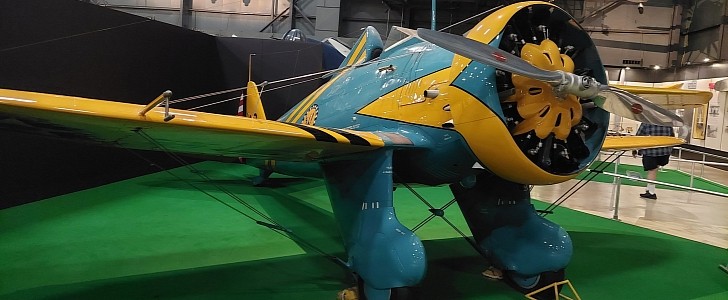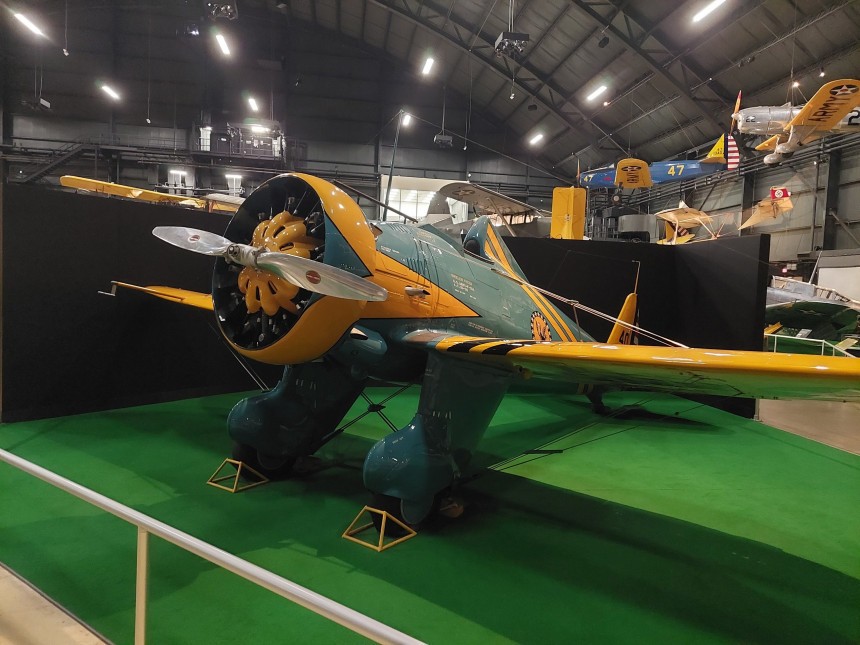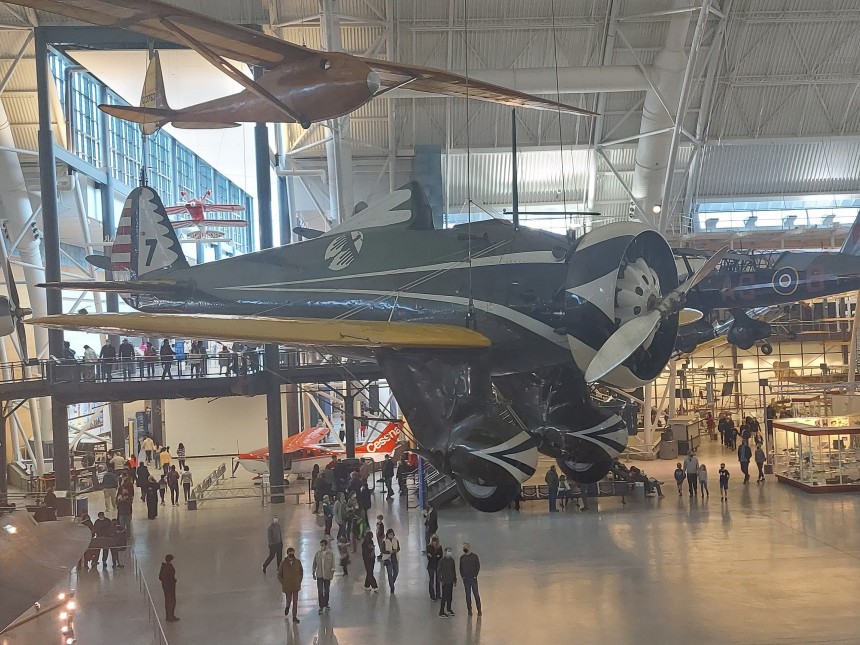If you're familiar at all with Boeing, it's likely because of their world-famous big airliners, the 707, 747, and so on. But one area the current world's largest aerospace company neglected for over seven decades was the single-engined fighter role.
The Boeing Company was awarded the production maintenance contract for the absorbed McDonnel-Douglas FA-18 Super Hornet in the early 2000s, but before that, you have to go all the way back to the early 1930s.
In those days, most fighters were still bi-planes and had construction makeups that used as little metal as possible to save weight. With this in mind, and as diminutive as it may be to modern sensibilities, the Boeing P-26 Peashooter was as advanced and as innovative as Boeing engineers could have possibly designed in the golden age of aviation.
It was a single-engine, all-metal monoplane with fixed landing gear, an open cockpit, and two M1919 .30 caliber machine guns in the nose for air to air combat. Under the proverbial hood of this fighter was an R-1430 nine-cylinder radial engine from Pratt & Whitney. The upgraded P-26B variant even received an engine variant with a very early fuel injection system and one of its M1919 guns replaced with an M2 Browing .50 caliber unit.
While no doubt still a monoplane, the P-26s wings had to be braced with wire to ensure structural integrity. The Peashooter derives its name not from its comparatively puny stature or armament. Instead, from the long and slender gun-sight tube that extended past the outside of the cockpit and into the open air outside, similar in size and shape to the child's toy.
In a vacuum, and in the context of the period in which the Peashooter was first flown, there was every reason to think the platform would have a long and successful career as a fighter. But in the first four decades of manned flight, progress came swiftly and at an unrelenting pace.
To give you a rough idea of what we mean, consider that within five years of the Peashooter's first flight, icons of World War Two like the Messerschmitt Bf-109, Hawker Hurricane, and Grumman F4F Wildcat were already taking to the skies. Meanwhile, the Peashooter didn't even have a canopy.
Against competition like that, the Peashooter looked out powered, outgunned, and frankly, several leagues out of its depths. Even so, Peashooters did indeed see combat in the skies over the Second World War. Special export variants were delivered to the Air Forces of China and the Philippines to aid in their battle against the encroaching Imperial Japanese menace.
It may surprise you that the Peashooter managed to claim a handful of air to air kills during this time. Some were even against the deadly Mitsubishi A6M Zero in the early days of the Pacific Theater. But a few fluke kills at the hands of supremely skilled pilots wasn't enough to keep the aircraft in service. The remaining Peashooters were retired or delivered to foreign Air Forces like Guatemala, who used them as trainers and emergency fighters well into the 1950s.
Apart from a handful of failed prototypes, including the X-32 Joint Strike Fighter program competitor, Boeing wouldn't again build or service fighter aircraft. Choosing to focus on strategic bombers in its military initiatives. Like the B-17 Flying Fortress, B-29 Superfortress, B-47 Stratojet, and B-52 Stratofortress.
That was, of course, until they were awarded the contract to maintain and produce new versions of the Mcdonnel-Douglas FA-18 Super Hornet in 2002. An astonishing 70 years separate the Peashooter from the Super Hornet. Today, only two period-correct Peashooters survive.
One is on display at the National Museum of the United States Air Force in Dayton, Ohio. The other is displayed at the Steven F. Udvar-Hazy Center in Chantilly, Virginia. The official annex of the Smithsonian National Air and Space Museum in Washington D.C.
We took separate trips to see both examples in Virginia and Ohio, respectively, it was two experiences that blew our minds as much as it did humble us. Be sure to check out our in-depth review of each museum and so much more right here on autoevolution.
In those days, most fighters were still bi-planes and had construction makeups that used as little metal as possible to save weight. With this in mind, and as diminutive as it may be to modern sensibilities, the Boeing P-26 Peashooter was as advanced and as innovative as Boeing engineers could have possibly designed in the golden age of aviation.
It was a single-engine, all-metal monoplane with fixed landing gear, an open cockpit, and two M1919 .30 caliber machine guns in the nose for air to air combat. Under the proverbial hood of this fighter was an R-1430 nine-cylinder radial engine from Pratt & Whitney. The upgraded P-26B variant even received an engine variant with a very early fuel injection system and one of its M1919 guns replaced with an M2 Browing .50 caliber unit.
While no doubt still a monoplane, the P-26s wings had to be braced with wire to ensure structural integrity. The Peashooter derives its name not from its comparatively puny stature or armament. Instead, from the long and slender gun-sight tube that extended past the outside of the cockpit and into the open air outside, similar in size and shape to the child's toy.
To give you a rough idea of what we mean, consider that within five years of the Peashooter's first flight, icons of World War Two like the Messerschmitt Bf-109, Hawker Hurricane, and Grumman F4F Wildcat were already taking to the skies. Meanwhile, the Peashooter didn't even have a canopy.
Against competition like that, the Peashooter looked out powered, outgunned, and frankly, several leagues out of its depths. Even so, Peashooters did indeed see combat in the skies over the Second World War. Special export variants were delivered to the Air Forces of China and the Philippines to aid in their battle against the encroaching Imperial Japanese menace.
It may surprise you that the Peashooter managed to claim a handful of air to air kills during this time. Some were even against the deadly Mitsubishi A6M Zero in the early days of the Pacific Theater. But a few fluke kills at the hands of supremely skilled pilots wasn't enough to keep the aircraft in service. The remaining Peashooters were retired or delivered to foreign Air Forces like Guatemala, who used them as trainers and emergency fighters well into the 1950s.
That was, of course, until they were awarded the contract to maintain and produce new versions of the Mcdonnel-Douglas FA-18 Super Hornet in 2002. An astonishing 70 years separate the Peashooter from the Super Hornet. Today, only two period-correct Peashooters survive.
One is on display at the National Museum of the United States Air Force in Dayton, Ohio. The other is displayed at the Steven F. Udvar-Hazy Center in Chantilly, Virginia. The official annex of the Smithsonian National Air and Space Museum in Washington D.C.
We took separate trips to see both examples in Virginia and Ohio, respectively, it was two experiences that blew our minds as much as it did humble us. Be sure to check out our in-depth review of each museum and so much more right here on autoevolution.










